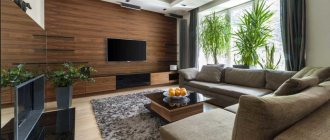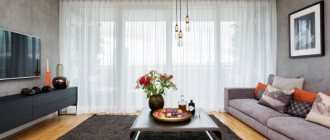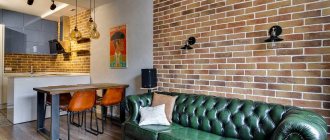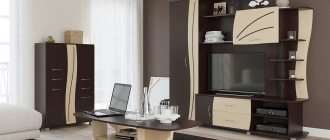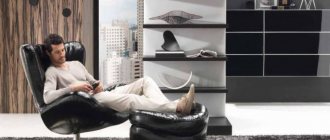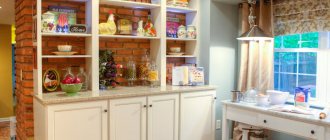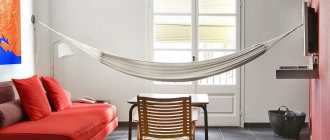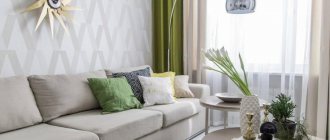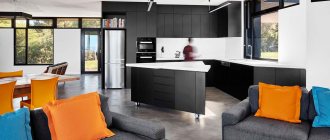Walls are important elements of the interior, occupying large spaces and serving as a backdrop for furniture, paintings, other useful items and decorative elements. But everything can change radically if you make a bright accent on the wall, which occupies the main place in the room, which is the object of everyone’s attention and the calling card of the entire house. In most residential homes, this is the living room. Such a wall is called an accent wall; it differs significantly from all other walls in its color, texture, pattern, and image.
Placing the right accents by highlighting one wall is a simple and very common way to create an original interior.
The emphasis is on the wall that first comes into view when a guest enters the room; there cannot be two or more of them. The first 15 seconds in a new room become the main ones for the perception of information; all subsequent impressions will only be superimposed on the already developed judgment. They don’t always finish the entire wall, sometimes a part of it is enough, it all depends on the size of the room. According to psychologists, a properly accentuated workspace disciplines, and an accentuated place for rest allows the body to recover.
Basic rules for creating an accent wall in the living room
There are a large number of design techniques for creating accent walls, which solve a number of problems:
- This is an opportunity to bring bright colors, increased lighting, new lines and shapes into the interior that attract attention and create the right atmosphere. The space begins to acquire integrity and a certain charge of energy.
- This is the first thing that guests who come to the house will see; all their attention will be occupied for a certain time by the accent wall in the living room, which can help in business negotiations or in the mood for rest and relaxation.
- Using accentuation, you can adjust the geometry of the wall. Straight vertical lines visually increase the ceiling. The use of mirrors allows you to expand the space of rooms. Highlighting a bright accent wall in the middle of a long narrow room can make it more holistic and harmonious.
- The room can be conditionally divided into several areas, in one part of the room it is more pleasant to sit near the fireplace, in another to communicate with guests, etc.
Combination of shades when combining wallpaper in the living room
In the design of a large room, you can use not only contrasting, but also related shades. These are two similar or the same tone of varying degrees of saturation.
Use the principles of the color wheel.
It is divided into 12 sectors. You can choose a range from one sector, two/three adjacent ones or from 2 opposite parts. Another harmonious combination is three palettes equidistant from each other. The picture below shows how to do this. The highlighted triangles contain shades that match each other.
There are also online services that make selection easier.
Also take into account the peculiarities of the psychological perception of gamma. For example, red and scarlet colors are considered aggressive: it is not recommended to use them in their pure form - a pattern or small inserts are enough.
- Orange. Cozy and active at the same time.
- Pink. Visually increases the space. Depending on the saturation, it can be calm or bright.
- White. A win-win in tandem with pastel colors and black inserts.
- Lilac, purple. Light variations visually expand the room.
- Green, blue. They calm you down and put you in a positive mood.
Techniques for creating an accent wall in a living room interior
There cannot be strict rules on this matter, but there are always recommendations that have been developed over decades of design practice. Color is one of the most important components of any room; if there is not enough light, mechanisms related to cold weather, loss of vital energy, etc. are activated in our head. When choosing the color of an accent wall, a number of factors are necessary:
- Intensity of natural light. Natural light is more pleasant and useful for the human eye; this resource must be used to the maximum, especially if it is not enough.
- The color of furniture elements, floors, ceilings, background walls.
- Interior style. For example, the Nordic style uses light but cool colors as a basis; the emphasis can be placed on the brightest colors. The classic style has darker primary tones; the emphasis should be placed more on contrasting colors.
- Living room size. For a large living room, it makes no sense to allocate the entire area for an accent wall; part of it is enough. This could be an area near the TV, bookcase, or desk.
There should be one accent wall, or in exceptional cases two, if the design idea requires it.
The color should suit all family members; not only well-being, but also human health depends on it.
Pastel colors are best used for rooms with windows facing north. If there is enough light, you can use cooler colors - blue, blue, turquoise, purple.
You can build an accent both on color contrast and on a softer combination of shades
How to combine wallpaper in the living room if it has a pattern
A win-win and simple option: pattern and plain coating. A little more complicated - two ornaments or geometric shapes with the same color or print. In the first case, the patterned canvas is glued to only one wall. Sometimes it resembles a big picture.
There is no need to load such a surface with objects - it looks best empty or with a mirror. Shades can be contrasting and related.
The second idea requires a careful approach to the choice of material and medium or large space. You can arrange the same or different palettes.
Look at the photo to get an idea of what it looks like.
A geometric print can be used to make a room look more formal or orderly. Some combinations look very interesting.
Decorative elements
The decorative element is a kind of cherry on the cake, the final component of the interior. His choice is a responsible matter and much more difficult than it might seem at first glance.
You can create an accent without resorting to repairs - just decorate the wall with decorative elements
The decorative element must be combined with the furniture, wall color, lighting, etc.
When decorating an accent wall we use:
- tapestries;
- paintings;
- aquarium or terrarium;
- family genealogical tree;
- panels made of ceramics, metal or wood;
- objects made by craftsmen or artists;
- painting on the wall;
- Children's drawings;
- collages from photographs.
The decorations will largely depend on the style of the interior. Each home owner chooses his own style, in which he will feel as cozy and comfortable as possible. A tapestry, mirrors in a large frame and paintings are ideal for classics; for a modern style, a large photograph, an aquarium of an unusual shape, the use of glass and mirrors will fit well.
Accent mirror on the wall of the living room in the style of modern classics
Rustic or loft styles love wood and clinker bricks in all its forms. The place near the fireplace can be decorated with wooden sculptures, animal horns, and ceramic panels. For the Mediterranean style, clay and metal sculptures made in ethnic style are suitable. Japanese style assumes minimalism and laconicism of shapes and colors; the emphasis can be placed on small shelves and niches on which you can put the most important and iconic items.
In a rustic interior, a wooden shelf will successfully serve as an accent.
Bohemian style combines an abundance of bright colors and unusual objects. Mirror wall decoration and unusual compositions will be most appropriate here. For the Nordic style, a bright painting or tapestry is best.
Wooden or wicker dishes are suitable for the accent wall of a boho room
Modern eclecticism (a mixture of different styles) in the interior is the norm rather than the exception to the general rule. Previously, cultures hardly mixed; now we have no shortage of communications and information. If you can take the best from different styles, then the boundaries between them are erased. The main thing is the attitude of a particular person to materials, forms and their combination. The accent wall in this case can be very diverse, but it should attract everyone's attention and be a source of warmth, inspiration and relaxation.
Creating an accent with modular paintings
Decorating an accent wall with wood cuts
An ordinary branch and directional lamps are a simple implementation of a very impressive decor
Handmade from wallpaper
Calculate the exact cost of repairs using an online calculator
and receive a free detailed estimate for repairs
Calculate
This is a labor-intensive option, but very beautiful if you have enough imagination and patience to implement it. Choose unusual wallpaper, including leftover wallpaper from previous renovations. Cut squares of the same size and place them on the wall in any order. For the brightest square, choose an accent of the same color, such as a pillow or lamp.
Photo: abstinencedu.com
Lighting
Additional lighting can add new colors to a beautiful, already familiar interior, making it possible to show its relief, volume, and focus on certain objects. Spotlights, sconces, and floor lamps are suitable for this.
Accent lighting allows you to highlight the necessary details, for example, pictures, niches, shelving or curtains
The play of light and shadows magically transforms the appearance of the room
An aquarium or terrarium can be the most attractive additional lighting. Aquarium lighting produces the most pleasing colors to the eye. An aquarium can occupy quite a lot of space and completely reproduce marine or freshwater flora and fauna. The lighting reflects very beautifully from varnished wooden surfaces; the texture of the wood and its pleasant warm color are clearly visible.
An aquarium can become a highlight of the interior if you choose a non-standard place or an unusual shape for it.
Original ways to focus on one wall
Taking advantage of the variety of possibilities, interior designers create non-standard, stunning variations of the accent wall:
- Ring cuts of wood
- Antique posters
- Microcement coating
- World map
- Graffiti
- Fabric panels
- Patchwork and much more
Patchwork accent wall
Wood accent wall
Accent wall made from wood cuts
Accent wall in the bedroom with inscriptions
Accent on the wall
Interesting accent wall design ideas in the living room
The phytowall will not leave anyone indifferent, especially for those who love plants. Additional plant lighting makes it possible to enjoy the green color of living plants.
A phytowall or a small picture of living plants looks luxurious and unusual in the interior of the living room.
A phytowall can be built in several ways:
- Using special phytomodules equipped with autonomous watering. The solution is not cheap, but it makes it possible to devote a minimum of time to plants.
- Buy brackets, frames and install the plants yourself.
Phytowall has a refreshing and calming effect.
Contrasting wall in a small room - yes or no?
This is probably one of the main questions that gets in the way of creating something special for many ordinary people. After all, you don’t want to make an already small room even smaller by ineptly choosing the color. An option underestimated by many is decorating one of the walls in a dark color . This is a great option for a small room! And if it, moreover, has a rectangular shape, then painting the end wall will help visually correct the geometry of the room .
Dark tones will add depth and expressiveness to your room.
very noble , but at the same time calm and neutral. The deep and muted blue color will put you in the mood for relaxation, thanks to its calming effect on the human psyche. And dark shades of wood and chocolate tones will look not only noble, but also very rich . By painting one of the walls with a rich dark shade, and the rest with white or other light, pastel shades that match the color of the ceiling, you will not only “ expand ” the space, but also erase the boundary between the walls and the ceiling, making the ceiling visually higher. If the height of the room is sufficient, you can paint the ceiling and one of the walls with a dark color, this will look very unusual and will also create the effect of blurred boundaries .
Photo: 50 more ideas for decorating an accent wall in the living room
How to decorate a room with a ledge in the wall
An accent wall in the bedroom can be “tied” to the bed by painting the wall behind the headboard in a contrasting tone. If the bed is placed sideways to the wall, the wallpaper will wear out and get dirty, so it is necessary to protect this area of the room. The best option would be a panel made of cork or aged wood, which goes well with the loft style or Scandinavian motifs. If the bedroom is decorated in Provence style, a fabric panel with a floral print will serve as an accent.
Note! Creating an accent wall will help hide the imperfections in the layout of rooms of irregular proportions.
If the entrance to a narrow and long bedroom is located along a long wall, you can visually divide it into a sleep and relaxation area. Near the bed, stick wallpaper in calm shades with an unobtrusive pattern, place an armchair and table in the opposite part of the room, and highlight this area with a bright color. Some apartments located in older housing stock have projections or niches in the rooms or kitchen. Disadvantages of the layout can be turned into advantages by playing with them with color or texture. In kitchen ledges, as a rule, there is a ventilation duct.
There are two ways to use a ledge: hide it behind furniture, or make it a decoration for the room. The second method will add personality to the room. We offer several options:
- Paint the front part of the ledge in a bright color, choose textiles that suit the style and shade;
- Hang photographs or posters on the front wall;
- Paint the wall with chalkboard paint; you can write the menu for the day on this makeshift board.
Important! Dismantling ventilation ducts is prohibited by fire safety regulations.
Why create an accent in the interior?
The main advantage is that it makes the space of any room noble, modern and stylish. The presence of a thoughtful accent in the interior indicates the thoughtfulness of the design and good taste of the owners of the house.
The emphasis is created to attract attention or designate (zoning) a specific area; it is often used in rooms in which different functional areas are combined, this is especially true for studio apartments.
Also, the presence of a different wall allows you to give the interior more dynamics and activity. Therefore, if you want to get a bright, rich interior of a particular room, then a contrasting wall in it will help with this. Especially if it is of some bright color or simply an interesting design that attracts the eye.
Also, many designers often use an accent wall to visually adjust a room. After all, with its help you can make the room more elongated and narrow.
Use liquid wallpaper
Liquid wallpaper does not have seams like paper wallpaper, so this type of finish will visually smooth out the corner. It will help to level it, fill all the cracks and unnecessary bends in the walls. Using a stencil and two colors you can create a beautiful design and highlight a corner. Turn it into an art object.
Liquid wallpaper can be easily restored if damaged. They are elastic, look beautiful and serve as a reliable protector of walls, especially protruding parts.
